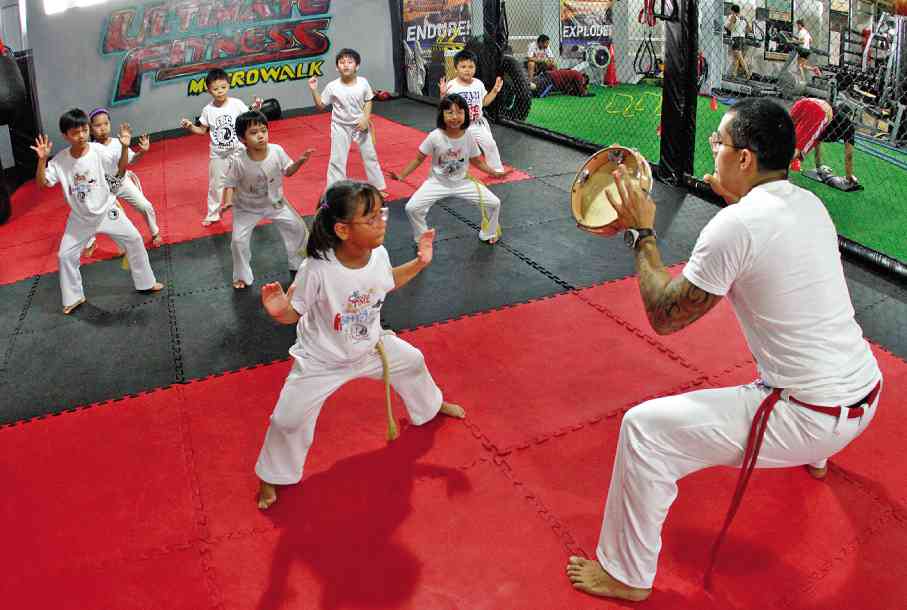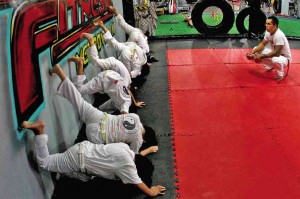
in Metrowalk, Pasig City
Except for the uniform white tees and loose white pants with white ropes swinging from their tiny waists, the children and their teacher could very well pass themselves off as a nursery school class at play.
But this, in fact, is a martial arts class unlike any other, devoid of sharp kicks, fisted hands in combative stance, and throaty yelps of “yaaah!” At the center of it all is a young man whose red rope belt indicates a much higher stature, a prowess attained to merit a color, and an ethereal name, “Fantasma,” to match.
This is capoeira, a Brazilian form of martial arts that employs music (with live players sometimes), rhythmic moves that look like dance steps, singing, somersaults and fan kicks, among others.
Capoeira had its beginnings in Portuguese colonialized Brazil in the 16th century, when African slaves developed this self-defense martial art under the guise of a dance.
Although the slaves outnumbered their colonizers, they were nevertheless unarmed. Developing this art of self-defense gave them hope for survival. Thus, it flourished among the African 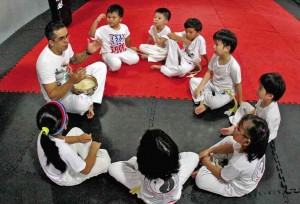 slave tribes.
slave tribes.
With the abolition of slavery in the 19th century, the African slaves found themselves jobless. The art, which was by now widespread, came into misuse when criminals and war lords employed capoeristas as bodyguards, leading authorities to ban capoeira, hunting down its practitioners, torturing and maiming them. It was only in 1937 that the art was revived as a sport.
In 1940, Mestre Bimba, a strong fighter from Salvador, established the first legitimate school of capoeira, employing a systemic teaching method, teaching the art to the elite.
Teaching capoeira to children requires a different approach. “The moves come naturally to kids,” explains Fantasma. “That’s why capoeira is attractive to them.”
Games
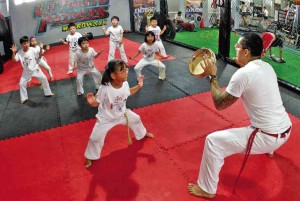 An hour-long lesson is comprised of capoeira fundamentals.” I associate the moves with games, and the children get excited,” explains Fantasma. He gets young, restless ones to focus by injecting fun while teaching the fundamentals. The basic step, called “ginga,” looks like a dance step: One foot steps back alternately as the opposite arm swings alternately from side to front of face.
An hour-long lesson is comprised of capoeira fundamentals.” I associate the moves with games, and the children get excited,” explains Fantasma. He gets young, restless ones to focus by injecting fun while teaching the fundamentals. The basic step, called “ginga,” looks like a dance step: One foot steps back alternately as the opposite arm swings alternately from side to front of face.
Almost instinctively, children tend to step forward instead of back. But eventually, the rhythm sinks in. The ginga is an essential move in capoeira in that the capoerista has to learn to be in constant motion when warding off an attack, confusing the opponent.
Cartwheels and handstands are part of the essential capoeira moves. Legwork, acrobatics, and rolls are taught a step at a time to children as young as 3 years old.
First, Fantasma positions the children with their backs on the floor with their arms supporting them up, then a quick turn and the children go into a kind of “downward dog” position, then go back to a seated position with a leg up in front.
A more advanced move would require the capoerista to get his leg up while in a downward position. To familiarize the children with that, Fantasma holds one little leg up, supported by a 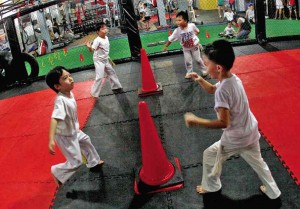 stool or chair. Eventually, this move is done in one swift sweep.
stool or chair. Eventually, this move is done in one swift sweep.
Then, to make the children used to the feel of a fan kick, the mestre (master) lets the children swing their legs over and above a stool.
For the singing part, Fantasma sits the children in a circle, and picks up a pandeiro (tambourine), traditionally part of a capoeira “band” which includes a single-headed standing drum (atabaque), a double bell (agogo), and a stringed instrument made of bamboo (reco-reco). He taps out a synchopated rhythm on the pandeiro and sings, “Parana-eh, parana-eh parana,” as the children echo him, then continues on to the next verse. Again the children echo him until the end of the song.
‘Music is 90 percent’
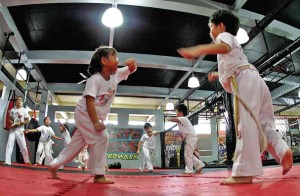 “It’s natural with kids,” says Fantasma, “because the moves are connected to rhythm. Music is 90 percent of the art. Children understand the music and the singing, and music is big here,” he observes of this country, which he describes as his “destiny,” having settled down here with his Filipina wife, Christine Tan, whom he met on the capoeira floor.
“It’s natural with kids,” says Fantasma, “because the moves are connected to rhythm. Music is 90 percent of the art. Children understand the music and the singing, and music is big here,” he observes of this country, which he describes as his “destiny,” having settled down here with his Filipina wife, Christine Tan, whom he met on the capoeira floor.
Ever the patient and joyful mestre, the children reciprocate Fantasma’s joy of teaching them by climbing on his back, clinging to his leg and giving him back the enthusiastic “high five” which he extends to them when they do well.
“Fantasma” is the name Alessandro Coqueiro earned when he was 12 years old. Like all other capoeristas, one is given a name by his mestre upon his “baptism,” depending on what impression he gives by his moves, by his prowess, by his style and repute.
In the case of Fantasma, his mestre, Oscar, named him thus after suddenly noticing the wisp of a boy who appeared out of nowhere, like a ghost or phantom, doing moves at par with the older students.
Children’s Capoeira is the newest class opened by Escola Brasiliera Capoeira (EBC), an affiliate of its mothership in Brazil, and has been in the Philippines for some 10 years now. The sport first attracted Nicole Severino, who had taken up capoeira in Singapore.
A trip to Brazil with other early practitioners like Cookie Duran and Roman Bito led to the establishment of EBC in the Philippines, which today has an 80-strong adult membership, and 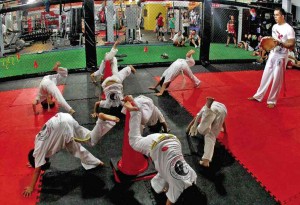 20 children aged 3-7.
20 children aged 3-7.
The first children’s class in Manila started last year, with the young children of the adult capoeira students in attendance, including Fantasma’s 7-year-old daughter Iara.
This summer, capoeira for children has found its way into the to-do list of mothers eager to fill the vacation days of their children. Perhaps another attraction to the sport is that capoeira has been made part of soccer training in Brazil, famous for quick-footed, sensational top goal-scoring players at the World Cup like Ronaldo and Ronaldinho.
Fantasma teaches two children’s classes in two locations: at the Ultimate Fitness Gym in Metrowalk, and at Arts in the City at Bonifacio Global City. From the enthusiasm it has received, it looks like classes will continue way after summer is over. Plans are underway to introduce capoeira to schools.
Visit www.ebcphilippines.com or www.facebook/ebcphilippines. Call 0917-8515900.
PHOTOS BY RICHARD A. REYES

